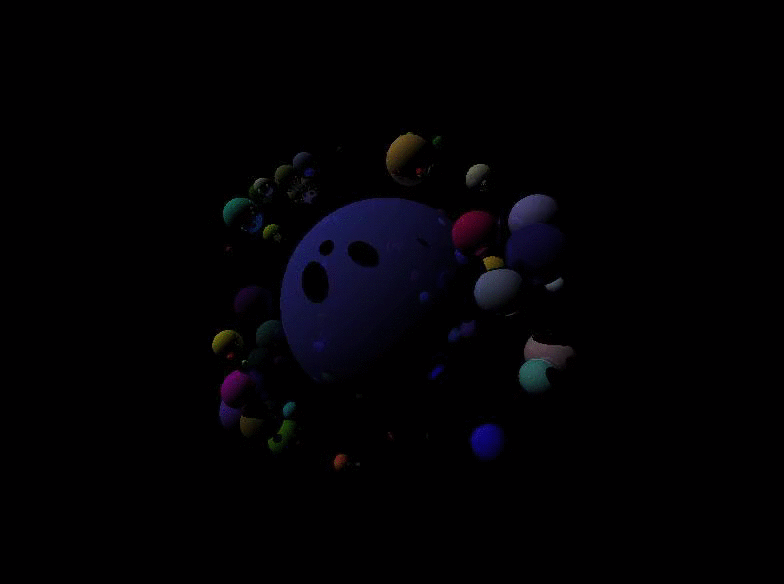

ANYWAY, here's the code.
Code: Select all
--How to create the raycast GLSL code
-- call generateglslcaster(data)
-- returns a string of glsl code
-- the code contains a function called raycast
--How to call the raycast function
--bool raycast(in vec3 o,in vec3 d,out vec3 pos,out vec3 norm,out vec4 color)
-- Returns whether the ray hit anything
-- o is the origin of the ray
-- d is the direction of the ray
-- pos is where the ray hits the object
-- norm is the normal of where the ray hits the object
-- color is the color of the object the ray hit
--Groups nearest spheres together
--This make a log-time ray search
--Way better than octrees... if you don't need to move anything.
local function partition(spheres)
if #spheres==1 then
return spheres[1]
else
local newspheres={}
local taken={}
for i=1,#spheres do
if not taken[i] then
local b0=spheres[i]
local bestr=1/0
local bestj
for j=i+1,#spheres do
if not taken[j] then
local b1=spheres[j]
local r
local d=((b1.x-b0.x)*(b1.x-b0.x)
+(b1.y-b0.y)*(b1.y-b0.y)
+(b1.z-b0.z)*(b1.z-b0.z))^0.5
if d+b0.r<b1.r then
r=b1.r
elseif d+b1.r<b0.r then
r=b0.r
else
r=(d+b0.r+b1.r)/2
end
if r<bestr then
bestr=r
bestj=j
end
end
end
if bestj then
taken[i]=true
taken[bestj]=true
local b1=spheres[bestj]
local d=((b1.x-b0.x)*(b1.x-b0.x)
+(b1.y-b0.y)*(b1.y-b0.y)
+(b1.z-b0.z)*(b1.z-b0.z))^0.5
if d+b0.r<b1.r then
newspheres[#newspheres+1]={
a=b0;
b=b1;
x=b1.x;
y=b1.y;
z=b1.z;
r=b1.r;
}
elseif d+b1.r<b0.r then
newspheres[#newspheres+1]={
a=b0;
b=b1;
x=b0.x;
y=b0.y;
z=b0.z;
r=b0.r;
}
else
local c0=((b0.r-b1.r)/d+1)/2
local c1=((b1.r-b0.r)/d+1)/2
newspheres[#newspheres+1]={
a=b0;
b=b1;
x=c0*b0.x+c1*b1.x;
y=c0*b0.y+c1*b1.y;
z=c0*b0.z+c1*b1.z;
r=bestr;
}
end
end
end
end
for i=1,#spheres do
if not taken[i] then
newspheres[#newspheres+1]=spheres[i]
end
end
return partition(newspheres)
end
end
--Bounds all the objects into minimum size spheres.
--Because the only datatype is sphere, this is kind of useless, but whatever.
--I _was_ planning on adding more shapes
local function makespheres(data)
local spheres={}
for i=1,#data do
local g=data[i]
if g.type=="sphere" then
spheres[i]={
x=g.cx;
y=g.cy;
z=g.cz;
r=g.r;
g=g;
}
end
end
return spheres
end
--code to check if the ray intersects a partition sphere
local pcheck=[[
$tco=$c-o;
$tu=dot(d,co);
$tv2=u*u-dot(co,co)+$r;
$tif(0<v2&&0<u+sqrt(v2)&&u-sqrt(v2)<bestt){
$t //Optimization: &&0<u+sqrt(v2)&&u-sqrt(v2)<bestt
$t //I haven't tested it but I think square roots are significantly faster than more if statements
]]
--Solves the intersection of the ray and a sphere object
--sets hit distance, hit position, hit norm, and color
local solvesphere=[[
$t vec3 co=$c-o;
$t float u=dot(d,co);
$t float v2=u*u-dot(co,co)+$r;
$t if(0<v2){
$t float t=u-sqrt(v2);
$t if(0<t&&t<bestt){
$t bestt=t;
$t pos=o+t*d;
$t norm=normalize(pos-$c);
$t color=$q;
$t }
$t }
]]
--recursively hardcodes the partition checks and object solvers.
local function writecode(p,tabs)
tabs=(tabs or "").."\t"
local s0=string.gsub(pcheck,"$(.)",function(c)
if c=="c" then
return "vec3("..p.x..","..p.y..","..p.z..")"
elseif c=="r" then
return p.r*p.r
elseif c=="t" then
return tabs
end
end)
local g=p.g
if g then
if g.type=="sphere" then
local s1=string.gsub(solvesphere,"$(.)",function(c)
if c=="c" then
return "vec3("..g.cx..","..g.cy..","..g.cz..")"
elseif c=="r" then
return g.r*g.r
elseif c=="t" then
return tabs
elseif c=="q" then
return "vec4("..g.cr..","..g.cg..","..g.cb..",1)"
end
end)
return s0..s1..tabs.."}\n"
--elseif g.type=="convexmesh" then LOLOLOL Not going to happen
end
else
return s0..writecode(p.a,tabs)..writecode(p.b,tabs)..tabs.."}\n"
end
end
--Makes the glsl ray caster from the given data
local function generateglslcaster(data)
local part=partition(makespheres(data))
return [[
bool raycast(in vec3 o,in vec3 d,out vec3 pos,out vec3 norm,out vec4 color){
d=normalize(d);
float bestt=1.0f/0.0f;
vec3 co;
float u;
float v2;
]]..writecode(part)..[[
return bestt<1.0/0.0;
}
]]
end
--Trash code after this point.
--Make a bunch of spheres.
local data={}
for i=1,64 do
--shitty non-uniform distribution.
local cx=math.random()-0.5
local cy=math.random()-0.5
local cz=math.random()-0.5
local c=7.5/(cx*cx+cy*cy+cz*cz)^0.5
cx,cy,cz=c*cx,c*cy,c*cz
data[i]={
type="sphere";
cx=cx;
cy=cy;
cz=cz;
cr=math.random();
cg=math.random();
cb=math.random();
r=math.random();
}
end
data[65]={
type="sphere";
cx=0;
cy=0;
cz=0;
cr=0.25;
cg=0.25;
cb=0.75;
r=5;
}
--Create the caster
local caster=generateglslcaster(data)
--Create the tracer
--This is the part you rewrite to make less cruddy
local effecttracer=[[
extern float w=800;
extern float h=600;
extern vec3 cp=vec3(0,0,0);
extern vec3 cx=vec3(1,0,0);
extern vec3 cy=vec3(0,1,0);
extern vec3 cz=vec3(0,0,1);
extern vec3 lightdir=normalize(vec3(1,1,1));
vec4 effect( vec4 _color, Image texture, vec2 p, vec2 screen_coords )
{
vec3 throwaway3;
vec4 throwaway4;
vec3 pos=cp;
//Notice how I'm not subtracting cz. It's because left hand rule is for cool peeps.
vec3 dir=w/h*(2*p.x-1)*cx+(1-2*p.y)*cy+cz;
vec3 norm;
vec4 color;
vec4 sumcolor=vec4(0,0,0,1);
vec4 mulcolor=vec4(1,1,1,1);
for(int i=0;i<10;i++){
bool hit=raycast(pos,dir,pos,norm,color);
if(!hit){
return sumcolor;
}
//Some craptastic light stuff.
hit=raycast(pos,lightdir,throwaway3,throwaway3,throwaway4);
if(!hit){
sumcolor+=0.5*max(0,dot(norm,lightdir))*mulcolor*color;
}
mulcolor*=color;
dir-=2*dot(dir,norm)*norm;
}
return sumcolor;
}
]]
--Compile the fragment shader
local effect=love.graphics.newShader(caster..effecttracer)
--In case you want to do something cool, hve a canvas
local canvas=love.graphics.newCanvas(800,600,"hdr")
love.graphics.setShader(effect)
--Position and angles... sort of.
local pos={10,10,10}
local mx,my=0,0
local sin=math.sin
local cos=math.cos
local function anglesyx(x,y)
local cx,sx=cos(x),sin(x)
local cy,sy=cos(y),sin(y)
--Inefficient. Oh well. This is trash code.
return {cy,0,-sy},{sx*sy,cx,cy*sx},{cx*sy,-sx,cx*cy}
end
function love.draw()
love.graphics.draw(canvas)
end
love.mouse.setRelativeMode(true)
function love.mousemoved(x,y,dx,dy)
mx=mx+dx
my=my+dy
local cx,cy,cz=anglesyx(my/256,mx/256)
effect:send("cx",cx)
effect:send("cy",cy)
effect:send("cz",cz)
end
local t=0
function love.update(dt)
t=t+dt
effect:send("lightdir",{0.5^0.5*sin(t),0.5^0.5,0.5^0.5*cos(t)})
if love.keyboard.isDown("escape") then
love.event.quit()
end
local cx,cy,cz=anglesyx(my/256,mx/256)
local dx=0;
local dz=0;
if love.keyboard.isDown("w") then
dz=dz+1
end
if love.keyboard.isDown("a") then
dx=dx-1
end
if love.keyboard.isDown("s") then
dz=dz-1
end
if love.keyboard.isDown("d") then
dx=dx+1
end
local d2=dx*dx+dz*dz
if 0<d2 then
local d=d2^0.5
dx=dx/d
dz=dz/d
end
if love.keyboard.isDown("lshift") then
dx=dx/16
dz=dz/16
end
pos[1]=pos[1]+dt*4*(dx*cx[1]+dz*cz[1])
pos[2]=pos[2]+dt*4*(dx*cx[2]+dz*cz[2])
pos[3]=pos[3]+dt*4*(dx*cx[3]+dz*cz[3])
effect:send("cp",pos)
end